Abstract
Irrigation and nitrogen management are crucial for sustainable potato (Solanum tuberosum L.) production. A field experiment was conducted during the 2022 and 2023 growing seasons at Farmington, New Mexico, to evaluate the performance of two chip potato varieties (Lamoka and Waneta) under three irrigation regimes (full irrigation (FI), 20% deficit irrigation (DI) and 40% DI) and seven nitrogen fertilizer rates (0, 60, 115, 170, 220, 280, and 340 kg N/ha). The treatment combinations of irrigation regimes, nitrogen rates, and varieties were arranged in a split–split plot design with three replications as main plot, sub-plot, and sub-sub plot, respectively. The two-year results showed that irrigation regimes had the most significant effect on plant growth, physiology, and tuber yield of the potato varieties. For both Lamoka and Waneta, the plant height and canopy cover were lower under 40% DI than under 20% DI and FI treatments. The SPAD meter values were higher under 40% DI, followed by 20% DI and FI treatments, whereas the stomatal conductance was higher under FI, followed by 20% DI and 40% DI during both growing seasons. Regardless of nitrogen rates and variety, a 20% water-saving irrigation strategy reduced the total tuber yield by 4.5% and 22.1% in the 2022 and 2023 growing seasons, respectively, while the 40% water-saving irrigation strategy reduced total tuber yield by 36.8% and 58.2% in the 2022 and 2023 growing seasons, respectively, as compared to full irrigation. Shifting from full irrigation to 20% DI could save 711.2 to 1036.3 m3/ha of irrigation water. For Lamoka, the highest total tuber yield was obtained with 60 kg N/ha under 20% DI and 220 kg N/ha under FI in 2022 and 2023, respectively. For Waneta, the highest total tuber yield was obtained with 115 kg N/ha under 20% DI and 170 kg N/ha under FI in 2022 and 2023, respectively. Maximum water use efficiency (WUE) was obtained at 60 kg N/ha with 20% DI for both Lamoka and Waneta in 2022, while maximum WUE was obtained at 220 kg N/ha under FI for Lamoka and at 170 kg N/ha for Waneta in the 2023 season. The maximum nitrogen use efficiency (NUE) was achieved with 60 kg N/ha under 20% DI for both varieties during both growing seasons. Thus, for sustainable irrigation and nitrogen management, the application of a 20% deficit irrigation strategy with a lower nitrogen rate (60 to 170 kg N/ha) could be the best option to improve WUE and NUE with minimal tuber yield reduction. Our study suggested that 40% deficit irrigation would not be beneficial as compared to both full irrigation and 20% water-saving irrigation.
1. Introduction
Potato (Solanum tuberosum L.) is the third most-consumed and fourth most-produced food crop in the world [1]. In the United States of America (USA), potato is the most consumed vegetable, with an annual production of 18.08 million metric tons that valued at USD 5.12 billion harvested from 368.83 thousand hectares of cultivated area in 2022 [2]. Potato has been recognized as a high potential food security crop for addressing the increasing global food demand [3,4,5]. Hence, the development of sustainable potato production practices that improve yield and quality of potato tubers is very important in maintaining global food security.
Water and nitrogen are the two important and highly discussed inputs used in potato production. Water is supplied to the potato plants through either precipitation or irrigation whereas nitrogen is supplied through the use of synthetic fertilizers, organic manures or by direct fixing of atmospheric nitrogen by nitrogen-fixing bacteria. Because of the shallow potato root system, potato irrigation should be carried out carefully to maintain sufficient soil moisture in its effective root zone depth of approximately 40 cm [6,7]. Potato water requirement varies from 350 to 650 mm depending upon climate, soil type, and variety [8]. In the United States, approximately 85% of the total potato harvested area is irrigated with an average national application rate of 21.6 acre-inches per acre (approximately 548.6 mm) of water [9]. To meet crop irrigation demand, excessive groundwater pumping has been commonly practiced in the Great Plains of the USA that could reduce irrigation water availability and crop acreage [10]. A study by McGuire [11] reported a water level decline of more than 45.7 m in some parts of the High Plain Aquifers during the period of 1950–2013. Similarly, subsequent drought, erratic rainfall patterns, and unprecedented breakage in the irrigation canals also may reduce the availability of seasonal irrigation water. Nitrogen is a major plant macro-nutrient that is necessary for normal plant growth, development, yield, and quality. Depending upon variety and location, the potential nitrogen uptake for potato plants ranges from 168 to 448 kg N/ha [12] while the economic optimum nitrogen application rate ranges from 147 to 201 kg N/ha [13]. Nitrogen fertilizer application rates beyond recommended dose may significantly reduce nitrogen recovery and nitrogen use efficiency with increased production costs [14].
There are interactions between irrigation water and nitrogen fertilizer application levels in the soil. Due to excessive irrigation water and chemical fertilizer inputs, the irrigated potato production systems could be a potential source of nitrate contamination in underground water [15]. Nitrate leaching beyond crop root zone increased with increasing nitrogen fertilizer rates under irrigated conditions as compared to non-irrigated potatoes [16]. A study by Vashisht et al. [17] predicted that the current potato production level could not be achieved even with the increased water and nitrogen input levels, while there could be 41–67% anticipated increase in leaching losses by the years 2058–2067. Similarly, irrigation rates and nitrogen fertilizer rates greatly affect water use efficiency (WUE) and nitrogen use efficiency (NUE). A study by Kassaye et al. [18] recorded the highest WUE under 50% deficit irrigation (DI), followed by 25% DI, and full irrigation, respectively. Similarly, Crosby and Wang [19] also found lower WUE under over-irrigated and fully irrigated conditions as compared to deficit irrigated plots. Thus, the deficit irrigation (DI) practice that applies water below crop evapotranspiration (ETc) requirement can be successfully used as an alternative water-saving irrigation strategy in the water limited arid and semi-arid regions [20]. Shrestha et al. [21] also concluded that a significant amount of irrigation water and nitrogen fertilizer could be saved with the application of light to moderate deficit irrigation coupled with lower nitrogen fertilizer application rates maintaining optimum potato tuber yield and quality.
Many previous studies have been carried out to assess the individual effect of either irrigation regimes or nitrogen fertilizer rates on potato growth, yield and resources use efficiencies. However, there have been very few studies carried out to assess the combined and interactive effects of irrigation regimes and nitrogen fertilizer rates on different potato cultivars. Thus, this research was carried out with the following objectives: (i) to evaluate the performance of two potato varieties under different nitrogen fertilizer rates and irrigation regimes, (ii) to investigate the interaction of irrigation strategies and nitrogen fertilizer rates on the physiological parameters of potato, and (iii) to explore the best intervals of water and nitrogen input to ensure water and nitrogen fertilizer conservation while maintaining optimum yield, quality, and water productivity.
2. Materials and Methods
2.1. Experiment Site
The experiment was conducted at New Mexico State University (NMSU) Agricultural Science Center, Farmington in the 2022 and 2023 growing seasons. The research site is located at 36.68308° N latitude and 108.31125° W longitude, with an elevation of 1720.20 m above sea level. The experimental location is shown in Figure 1. The experimental site is in a semi-arid climatic region with hot and dry summers and mild winters. The weather conditions during crop growing seasons in 2022 and 2023 are presented in Figure 2. The monthly average air temperature (°C) and monthly average relative humidity (%) during crop growth seasons were 17.0 and 22.9 (May), 21.8 and 35.6 (June), 24.2 and 48.1 (July), 22.7 and 53.9 (August), and 24.4 and 33.6 (September) in 2022; and 17.2 and 42.7 (May), 19.5 and 30.9 (June), 25.5 and 28.8 (July), 23.1 and 44.7 (August), and 19.4 and 47.6 (September) in 2023, respectively. The total solar radiation during crop growth period was 2929.7 MJ/m2 and 2993.29 MJ/m2 in 2022 and 2023, respectively. The weather was relatively warmer and drier in 2023 compared to 2022, as shown by the greater maximum air temperature, lower minimum, maximum, and mean relative humidity, and greater total solar radiation in 2023. The total rainfall amount received during the crop growth season in 2022 (84.6 mm) was higher than the total amount received in 2023 (26.4 mm). There were five rainfall events with depths greater than 8 mm during the 2022 growing season but no rainfall event with a depth greater than 8 mm was received during the 2023 growing season.
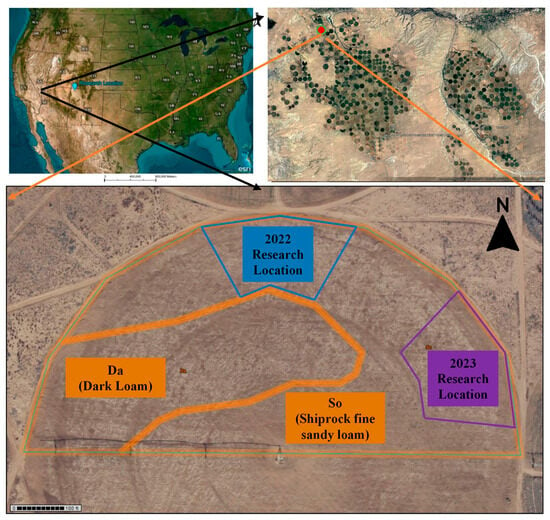
Figure 1.
Research location and soil types for the 2022 and 2023 growing seasons.
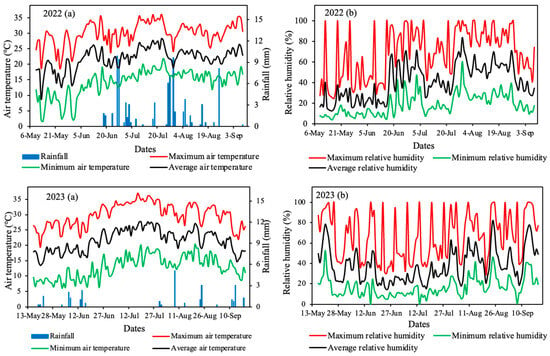
Figure 2.
Graphical representation of daily air temperature and rainfall (a), and relative humidity (b) during crop growth seasons at the experimental site in 2022 and 2023.
Soil samples were taken from five different spots in the field at the interval depths of 0–30 cm, 30–60 cm, 60–90 cm, and 90–120 cm before crop planting. Composite soil samples were prepared for each depth of the soil and sent to Ward Laboratories Inc., Kearney, Nebraska, USA for analyzing soil chemical properties (Table 1). The soil type in the experimental field was fine sandy loam with 68.5% of sand, 17.1% of silt, and 14.4% of clay. The soil bulk density was 1.5 g/cm3 and the pH of the soil was 8.3. The soil in the experimental field was well drained with a 2–5% slope and very low runoff. The average volumetric soil water contents at 15 bar (wilting point) and 1/3rd bar (field capacity) in 0–60 cm soil depth were 9.2% and 18.4%, respectively. The physical properties of soil were retrieved from Web Soil Survey, Natural Resources Conservation Service, United States Department of Agriculture [22].

Table 1.
Chemical properties of soil.
2.2. Experimental Design
The experimental design was a randomized split–split plot design with three replications. Three irrigation regimes (full irrigation: FI, 20% deficit irrigation: 20% DI, and 40% deficit irrigation: 40% DI) were assigned as main plots; seven different nitrogen rates (0, 60, 115, 170, 220, 280, and 340 kg N/ha) were assigned as sub-plots and two potato chip varieties (Lamoka and Waneta) were assigned as sub-sub plots. Lamoka and Waneta are chipping potato varieties developed by the Cornell potato breeding program. Lamoka was used as a check variety in this study. The irrigation treatments were randomly assigned to three sectors under a center pivot, and seven N rates were randomly assigned to each sub-plot. The experiment was conducted in different sections each year under the same center pivot and soil type. This particular configuration of irrigation and nitrogen replicates adopted in the current study differs from the standard split–split plot design and was chosen for the ease of management, which would not result in any significant additional errors to the results. In the 2022 growing season, potato seeds pieces were cut to an average size of 71 g and were planted on 9 May and harvested on 6–8 September, whereas in the 2023 growing season, potato seeds were planted on 16 May and harvested on 15–18 September. Seeds were planted in 0.86 m row spacing and 0.25 m plant spacing within a row. The individual sub-sub plot size was 9.87 m2 (3.81 m × 2.59 m) with three rows per plot and 15 plants per row. Potato cultivars were separated by planting four red potatoes (DT 6063-IR) and purple striped potato (Masquerade) in 2022 and 2023, respectively. Border plants and cover crops were planted between the main plots to avoid advection of heat and allow proper water management. Details of the factors used in the experiment are shown in Table 2.

Table 2.
Different factors and levels used within the experiment.
2.3. Crop Management
Before planting potatoes, Brassica juncea was grown as a cover crop and incorporated into soil at flowering stage as a green manure. In 2023 growing season, Brassica juncea plants did not grow well in the field. Soil ripping, ploughing, and harrowing were performed to prepare friable, loose, and well-aerated soil and the seed beds were prepared. Finely graded medium-sized potato seed tubers with an average weight of 2.5 ounces (70.87 g) were sown on the 9th and 16th of May in the 2022 and 2023 growing seasons, respectively, with two-row planter (Checchi & Magli, Budrio, Italy) at the depth of approximately 15 inches (38.1 cm). Dammer Diker was run after planting potatoes that cut-off the top 6-inch (15.24 cm) layer of the ridges and made small ditches on the furrows to reduce runoff and soil erosion and effectively distribute irrigation and rainwater within the plots. The granular form of urea (46-0-0) was top dressed at three split doses: 20% during vegetative stage, 60% at tuber development stage, and 20% at starch accumulation stage. Triple super phosphate (0-45-0) was applied at 23 kg/ha as a phosphorus (P2O5) source in both research years.
Valley X-Tec center pivot (ICON 5) (Valmont Industries Inc., Omaha, NE, USA) sprinkler irrigation system was used to irrigate the potato crops. Variable Rate Irrigation (VRI) with sector programming component of the center pivot was used to apply the three irrigation rates. During the sprout development stage, all plots received a total depth of 157.5 mm and 98.6 mm of irrigation water in the 2022 and 2023, respectively, to promote sprouting and emergence. The full irrigation treatment was irrigated at 35–40% management allowable depletion (MAD) while 20% DI and 40% DI treatments received 20% and 40% less water than the full irrigation treatment, respectively. Irrigation scheduling was based on Watermark soil moisture sensors (Irrometer Company Inc., Riverside, CA, USA). Watermark soil moisture probes were installed in all three whole plots at 15 cm, 30 cm, 45 cm, and 60 cm depths to monitor soil moisture. An AquaSpy soil moisture probe (AquaSpy Inc., San Diego, CA, USA) with sensors up to 120 cm depth was also installed in full irrigation (100% ETc) whole plot to monitor moisture in the soil profile. The center pivot was checked for the uniformity of application using Christiansen’s uniformity coefficient (CUC) (Equation (1)) [23]: The CUC was 91.94%.
where xi = irrigation depth in ith rain gauge (mm), = average irrigation depth (mm), and n = number of rain gauges.
Hand hoeing was performed for weed control in the plots. Weeds on the plant rows were removed through hand pulling. At harvest, tubers from the middle row of each plot were harvested and gathered separately using single row potato harvester (Checchi & Magli, Budrio, Italy) on 6–8 September in 2022 and 18–19 September in 2023. All the tubers harvested from middle row of each sub-sub plots were graded, counted, and weighed into different size categories based on tuber diameter: <4.76 cm, >4.76–<5.08 cm, >5.08 cm–<6.35 cm, >6.35–<7.62 cm, >7.62–<8.89 cm, and >8.89 cm. Deformed, diseased, damaged, and cracked tubers were counted as culls.
2.4. Observations Recorded
2.4.1. Observations Recorded for Plant Growth and Physiological Parameters
Plant population was counted at 25 days after planting from the middle row of each sub-sub plot. A meter scale was used to determine the plant height by measuring the height of randomly selected three plants from middle row of each plot as the distance from soil surface to the topmost growth point of the plant. The plant height measurement was taken at weekly intervals. Canopy cover was measured in percentage by Canopeo mobile application version 2.0 developed by the Oklahoma State University, USA. An adjustment value of 1.0 was used to measure canopy cover in the app, and measurements were taken based on the mid-row plants from arm height (approx. 130 cm from ground surface) following procedures mentioned in the app. Canopy cover measurements were taken throughout the plant growth period at weekly interval.
The SPAD-502 chlorophyll meter developed by Soil-Plant Analysis Development (SPAD) unit of Konica Minolta Inc., Tokyo, Japan was used to measure SPAD values corresponding to the chlorophyll content in the plant leaf. This device determines the leaf greenness (that correlates to chlorophyll concentration) based on the amount of light transmitted by the leaf in red and infrared regions. The accuracy of SPAD-502 chlorophyll meter is ±1.0 SPAD unit. The average SPAD values were measured during morning (9:00 a.m.–11:00 a.m.) on weekly interval from a leaf at approximately the middle height of each three randomly selected middle row plant per sub-sub plot.
Stomatal conductance was measured by using Delta-T AP4 Porometer (Delta-T Devices Ltd., Cambridge, UK) from a middle leaf of a randomly selected mid-row plant per sub-sub plot. It was measured in mmol m−2 s−1 unit. This device determines the stomatal conductance by measuring the change in humidity in the cup and leaf temperature. The accuracy of Delta-T AP4 Porometer device (Delta-T Devices Ltd., Cambridge, UK) is ±10% of readings from 5 to 800 mmol m−2 s−1 and ±20% of readings from 800 to 1200 mmol m−2 s−1. The stomatal conductance was measured three times a day, representing morning (8 a.m.), afternoon (2 p.m.), and evening (7 p.m.) from the leaves at approximately the middle height of plant canopy. The measurement was taken from a single replication because of the instrumental limitations and rapid changes in temperature and humidity.
2.4.2. Observations Recorded for Yield and Yield Components
Number of tubers per plant: The total number of tubers harvested from middle row of each sub-sub plot were counted and divided by number of plants harvested to obtain the number of tubers per plant.
Number of marketable tubers: The non-culled tubers with diameter between 4.76 cm and 8.89 cm were counted as marketable tubers.
Number of non-marketable tubers: All the diseased, rotten, insect damaged, deformed tubers and tubers with diameter less than 4.76 cm and greater than 8.89 cm were counted as non-marketable tubers.
Marketable tuber number ratio: It was calculated by dividing marketable tuber number by total tuber number. It was expressed in percentage (%).
Total tuber yield: The total fresh weight of tubers harvested from net plot area was used to calculate the total tuber yield in kg/ha.
Marketable tuber yield: Yield of non-culled tubers with diameter between 4.76 cm and 8.89 cm was taken as marketable tuber yield. It was calculated in kg/ha.
Non-marketable tuber yield: Yield of all the diseased, rotten, insect damaged, deformed tubers, and tubers with diameter less than 4.76 cm and greater than 8.89 cm was taken as non-marketable tuber yield. It was calculated in kg/ha.
2.4.3. Water Use Efficiency (WUE)
Water use efficiency (WUE), also called water productivity, can be defined as the ratio of crop yield and crop water use [24]. It was measured in kg/m3. WUE was calculated by using following formula (Equation (2)) [25]:
Total water supply is the sum of irrigation and rainfall amounts. The total water supply for 3 irrigation regimes in 2022 and 2023 research years are presented in Table 3.

Table 3.
Total water supply (mm) for irrigation regimes in 2022 and 2023.
2.4.4. Nitrogen Use Efficiency (NUE)
Nitrogen use efficiency (NUE) was measured in kg yield per kg applied nitrogen. It was calculated using following formula (Equation (3)) [26]:
where YN is the total tuber yield under nitrogen-treated plots (kg/ha), and Y0 is the total tuber yield in nitrogen-controlled plots, i.e., zero nitrogen-treated plots (kg/ha) and applied N rate in kg N/ha.
2.5. Statistical Analysis
Data collected in this experiment consisted of plant growth and physiological parameters, water and nitrogen use efficiencies, and tuber yield and yield components. The linear mixed model was used to analyze the data in R-programming (Version 4.3.2) using the ‘lme4’ package for each year [27]. Due to variable weather conditions in the 2022 and 2023 growing seasons, data from each year were analyzed separately. Irrigation, nitrogen rates, and variety were considered as fixed effects, while block was assigned as the random effect. The normal distribution of residuals was checked using residual plots and data were transformed as appropriate. The least square means and the adjusted Tukey multiple comparison test were used to compare the means of different treatments and interactions at p = 0.05 significance level using ‘emmeans’ package [28]. Statistical significance tests are not documented for plant height, canopy cover, and SPAD meter readings; instead, the measurements were pooled across either irrigation regimes or nitrogen rates for each cultivated variety for better data visualization.
3. Results
3.1. Plant Growth Parameters
3.1.1. Plant Height
In both growing seasons 2022, and 2023, full irrigation (FI) and 20% deficit irrigation (DI) regimes resulted in higher plant height than 40% DI for both Lamoka and Waneta potato varieties (Figure 3). The plant heights of potato plants under FI and 20% DI were similar in both growing seasons. The plateau of plant height was obtained earlier in 40% DI irrigation regime compared to 20% DI and FI treatments. Similarly, all the N fertilizer applied plots had higher plant height than nitrogen-controlled plots (0 kg N/ha) for both Lamoka and Waneta potato varieties and growing seasons (Figure 4). However, there were no distinct differences in the plant heights among N applied rates other than 0 kg N/ha. The average plant height of potatoes was relatively lower in 2023 than in 2022.
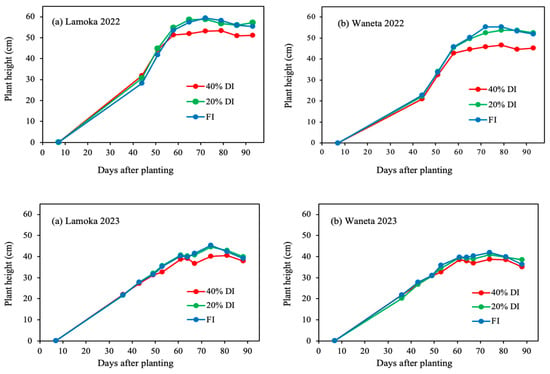
Figure 3.
Plant height of Lamoka (a) and Waneta (b) in 2022 and 2023 under different irrigation regimes; full irrigation (FI) and deficit irrigation (DI); each data point represents the value averaged over nitrogen rates.
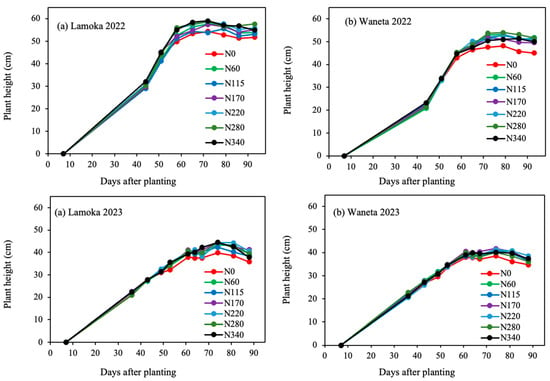
Figure 4.
Plant height of Lamoka (a) and Waneta (b) under different N application rates in 2022 and 2023; each data point represents the value averaged over irrigation regimes.
3.1.2. Canopy Cover
For both growing seasons, 2022 and 2023, FI and 20% DI showed significantly higher plant canopy cover than 40% DI treatment for both Lamoka and Waneta (Figure 5). In 2022, 20% DI and FI had statistically similar plant canopy cover, but 20% DI showed statistically lower canopy cover than FI in 2023. The plant canopy cover of Lamoka and Waneta was significantly affected by nitrogen treatments (Figure 6). For both growing seasons, nitrogen control plots resulted in the lowest plant canopy cover at all the observations. However, there were no significant differences in the plant canopy cover among N fertilization from 60 to 340 kg N/ha for both Lamoka and Waneta. The average plant canopy cover was relatively lower in 2023 than in 2022.
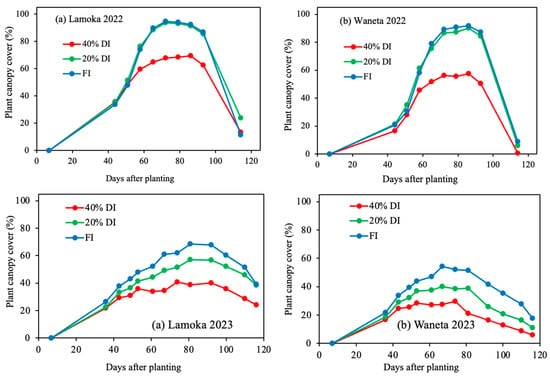
Figure 5.
Plant canopy cover of Lamoka (a) and Waneta (b) in 2022 and 2023 under different irrigation regimes; full irrigation (FI) and deficit irrigation (DI); each data point represents the value averaged over nitrogen rates.
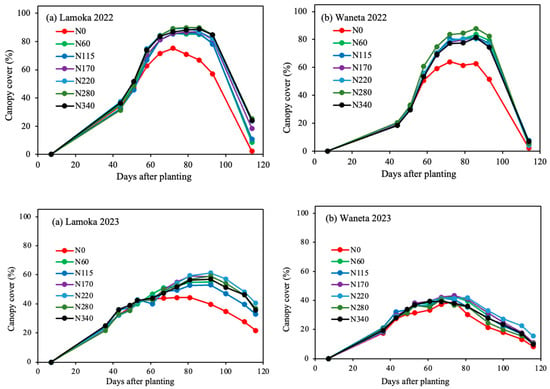
Figure 6.
Plant canopy cover of Lamoka (a) and Waneta (b) under different N application rates in 2022 and 2023; each data point represents the value averaged over irrigation regimes.
3.2. Plant Physiological Parameters
3.2.1. Chlorophyll Meter
The SPAD meter values were higher in deficit irrigation (DI) treatments than the values in full irrigation (FI) treatments for both potato varieties during the two growing seasons (Figure 7). In 2023, the highest SPAD meter values were obtained in 40% DI followed by 20% DI and FI, respectively. There was an increasing trend of SPAD values for all irrigation treatments after 60% of total N fertilizer was applied while SPAD values decreased accordingly with plant maturation. For both years, Waneta had a higher average SPAD meter value than Lamoka.
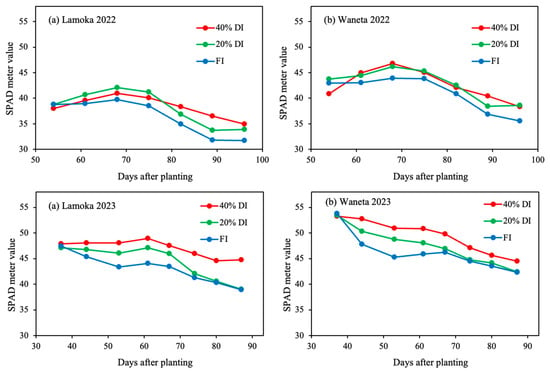
Figure 7.
SPAD meter values of Lamoka (a) and Waneta (b) in 2022 and 2023 under different irrigation regimes; full irrigation (FI) and deficit irrigation (DI); each data point represents the value averaged over nitrogen rates.
All the N fertilizer-treated plots had higher SPAD meter values than the controlled plots without N fertilizer application for both varieties and growing seasons (Figure 8). Generally, the SPAD values increased with an increase in N fertilizer rates for Lamoka in both years. However, for Waneta in 2022, the SPAD readings increased with increase in N rates up to 340 kg N/ha except the maximum SPAD readings obtained with 280 kg N/ha at 68 days after planting (DAP) and with 170 kg N/ha at 75 DAP. For Waneta in 2023, the SPAD values increased with N fertilizer rates up to 280 kg N/ha except at 61 DAP when N rate of 170 kg N/ha had the highest SPAD values.
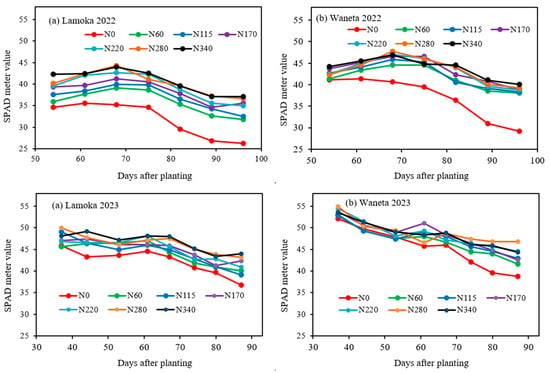
Figure 8.
SPAD meter values of Lamoka (a) and Waneta (b) under different N application rates in 2022 and 2023; each data point represents the value averaged over nitrogen rates.
3.2.2. Stomatal Conductance
The stomatal conductance values were averaged over different irrigation regimes regardless of N application rates to look at the stomatal conductance of each variety under the different irrigation regimes (Figure 9). The highest stomatal conductance of potato leaves was observed under the full irrigation (FI) regime followed by 20% deficit irrigation (DI) and 40% DI, respectively, at all observation times of the day for the two varieties and growing seasons. For FI and 20% DI irrigation regimes, the stomatal conductance was higher during 2 p.m. (afternoon) followed by 8 a.m. (morning) and 7 p.m. (evening), respectively. In 2023, FI treatments showed increased stomatal conductance at 2 p.m. from 37 to 61 DAP and then gradually decreased along with plant maturation for Lamoka. Under 40% DI in 2022, the stomatal conductance was lower at 2 p.m. than that at 8 a.m. for all observations. However, for 40% DI plots in 2023, the stomatal conductance at 2 p.m. was higher than at 8 a.m. from 37 to 44 DAP, and thereafter it was lower at 2 p.m. along with increased water stress. Both Lamoka and Waneta had varying response to N fertilizer rates for the average stomatal conductance. The average stomatal conductance (average of all of the stomatal conductance measurements) of Lamoka (310.3 mmol m−2 s−1) was 9.13% lower than that of Waneta (341.5 mmol m−2 s−1) in 2022; whereas the average stomatal conductance of Lamoka (217.5 mmol m−2 s−1) was 12.6% higher than that of Waneta (193.2 mmol m−2 s−1) in 2023.
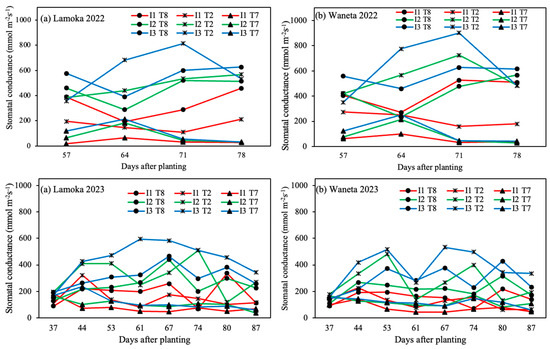
Figure 9.
Stomatal conductance of Lamoka (a) and Waneta (b) at different times of the day and irrigation regimes during growing seasons of 2022 and 2023. (I1: 40% deficit irrigation; I2: 20% deficit irrigation; I3: full irrigation; T8: 8 a.m.; T2: 2 p.m.; T7: 7 p.m.).
3.3. Tuber Yield and Yield Components
3.3.1. Tuber Number
Irrigation regimes significantly affected the tuber number per plant and marketable tuber number ratio (%) in both growing seasons with significant interaction of irrigation regimes and potato varieties in 2022 (Table 4). When averaged over N rates and varieties, the tuber number per plant was significantly higher in 20% deficit irrigation (DI) and full irrigation (FI) as compared to 40% DI irrigation. When averaged over nitrogen rates, the highest tuber number per plant was obtained for Waneta under full irrigation and the lowest tuber number per plant was obtained for Waneta under 40% DI as compared to other irrigation by variety combinations in 2022. In 2022, the highest marketable tuber number ratio was obtained under FI irrigation and 20% DI irrigation, which were statistically higher than 40% DI treatments. In 2023, the marketable tuber number ratio was higher under FI, followed by 20% DI and 40% DI irrigation, respectively. When averaged over irrigation and N rates, the marketable tuber number ratio was statistically similar between Lamoka (82.4%) and Waneta (81.4%) in 2022; however, Lamoka had significantly higher marketable tuber ratio (71.3%) than Waneta (67.9%) in 2023. When averaged over irrigation and varieties, N rates had no significant effect on marketable tuber number ratio in 2022; however, a significantly higher marketable tuber number ratio was obtained with 60 kg N/ha and the lowest marketable tuber number ratio was obtained with 340 kg N/ha in 2023. The average tuber number per plant and marketable tuber number ratio in 2023 were lower than in 2022 by 31.2% and 12.5%, respectively. It was observed that nitrogen rates had no significant effect on the tuber number during both growing seasons.

Table 4.
Mean comparison and p-value from F-test results on the effect of irrigation regimes, nitrogen rates, variety, and their interaction on tuber number per plant and marketable tuber number ratio in 2022 and 2023.
3.3.2. Tuber Yield
The full irrigation (FI) and 20% deficit irrigation (DI) produced significantly higher marketable and total tuber yields than 40% DI irrigation regime during both growing seasons regardless the applied N rates and potato varieties (Table 5). As compared to the full irrigation, the marketable tuber yield under 20% DI and 40% DI was reduced by 4.2% and 39.6% in 2022, respectively, and the corresponding reductions were 28.6% and 66.7% in 2023, respectively. Similarly, the total yield reduction under 20% DI and 40% DI accounted for 4.5% and 36.8% in 2022 and 22.1% and 58.2% in 2023, respectively. The nitrogen fertilizer rates significantly affected the tuber yield in 2022. Application of 60 kg N/ha produced significantly higher marketable and total tuber yields than 0 kg N/ha in 2022 and all N fertilizer rates greater than 60 kg N/ha did not significantly increase potato tuber yield during both growing seasons. When testing the effect of varieties pooled over irrigation and nitrogen effects, it was observed that the tuber yield of Lamoka was significantly higher than that of Waneta in 2023, whereas there was no significant difference in tuber yield between the two varieties in 2022.

Table 5.
Mean comparisons and p-values of F-tests on the effect of irrigation regimes, N rates and variety on the potato tuber yield, WUE, and NUE in 2022 and 2023.
In 2022, the highest marketable and total tuber yields for Lamoka were obtained with 60 kg N/ha under 20% DI irrigation regime (Figure 10 and Figure 11), whereas the highest marketable and total tuber yields for Waneta were obtained with 115 kg N/ha under FI followed by 60 kg N/ha under 20% DI in 2022. The 40% DI irrigation regime resulted in the lowest tuber yield at all nitrogen fertilizer rates compared to other irrigation regimes in 2022. In 2023, the highest marketable and total tuber yields for Lamoka were achieved with 220 kg N/ha under FI followed by 60 kg N/ha under FI. The highest marketable and total tuber yields for Waneta were achieved with 170 kg N/ha under FI followed by 0 kg N/ha under FI in 2023. The FI resulted in the highest tuber yields at all N applied rates, followed by 20% DI and 40% DI, respectively, in 2023.
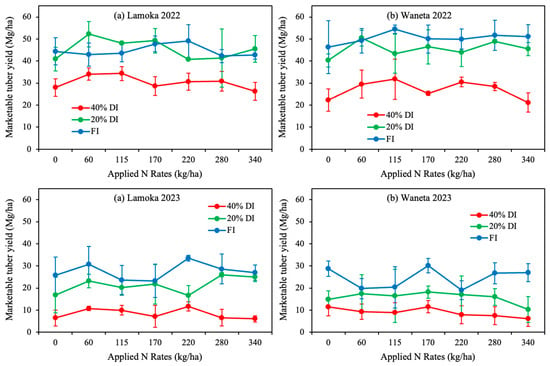
Figure 10.
Marketable tuber yield of Lamoka (a) and Waneta (b) under combinations of irrigation, full irrigation (FI) and deficit irrigation (DI), and nitrogen treatments in 2022 and 2023.
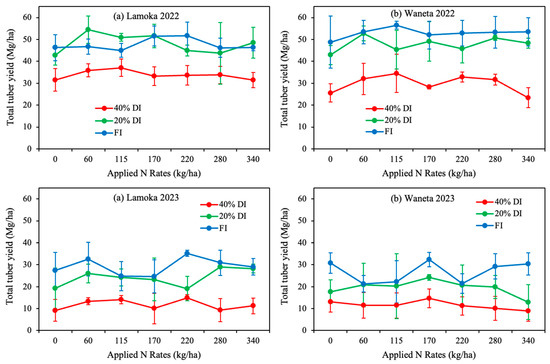
Figure 11.
Total tuber yield of Lamoka (a) and Waneta (b) under combinations of irrigation, full irrigation (FI) and deficit irrigation (DI), and nitrogen treatments in 2022 and 2023.
3.3.3. Tuber Size Distribution
The tuber number and tuber weight per row averaged over N fertilizer rates and potato varieties for different tuber sizes are shown in Figure 12. Irrigation regimes significantly affected the tuber size distribution regardless N rates and potato varieties. In 2022, the tuber number and weight for tuber diameter categories less than 6.35 cm were significantly higher under 40% DI than other irrigation regimes. The tuber number and weight for diameter 6.35–8.89 cm under 20% DI and full irrigation were statistically similar and significantly higher than their equivalences under 40% DI irrigation regime in 2022. In 2023, the deficit irrigation treatments had significantly higher non-marketable small-sized tuber (diameter < 4.76 cm) number and weight than the full irrigation. The 20% DI irrigation had higher tuber number and weight for tuber diameter 4.76–5.08 cm than other irrigation regimes, while for tuber diameter greater than 5.08 cm, the full irrigation regime had the highest tuber number and weight. The FI and 20% DI showed statistically similar tuber number and weight for the 5.08–6.35 cm tuber grade and which was significantly higher than the 5.08–6.35 cm tuber grade number and weight under 40% DI in 2023.
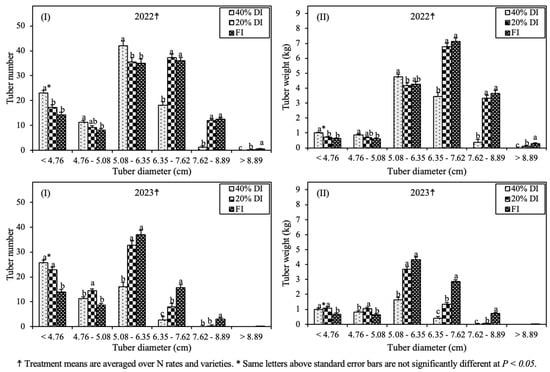
Figure 12.
Graph showing potato tuber number (I) and tuber weight (II) among various potato size distribution under different irrigation regimes, full irrigation (FI) and deficit irrigation (DI), in 2022 and 2023.
3.4. Water Use Efficiency (WUE)
Water use efficiency was significantly impacted by irrigation regimes (in both years), nitrogen rates (in 2022), variety (in 2023), and irrigation by variety interaction (in 2022) (Table 5). Regardless of applied N rates and variety, the lowest WUE was recorded under 40% DI irrigation in both research years, with the highest WUE under 20% DI irrigation (9.0 kg/m3) in 2022 and full irrigation (4.28 kg/m3) in 2023. In 2023, the WUE under 20% DI was statistically similar to full irrigation. The nitrogen application rates significantly impacted WUE in 2022. The highest WUE (8.56 kg/m3) was obtained with 60 kg N/ha when the irrigation and variety treatments are pooled together. The WUE decreased with increased N fertilizer rates beyond 60 kg N/ha in 2022. In 2023, significantly higher WUE was obtained in Lamoka (4.19 kg/m3) than in Waneta (3.77 kg/m3). The overall average WUE for 2022 and 2023 were 8.07 kg/m3 and 3.61 kg/m3, respectively. The highest WUE (kg/m3) for Lamoka under the FI, 20% DI and 40% DI irrigation regimes were obtained at N applied rates of 220 kg N/ha (8.56), 60 kg N/ha (10.21), and 115 kg N/ha (8.02) in 2022, respectively, and at 220 kg N/ha (5.37), 280 kg N/ha (5.26), and 220 kg N/ha (3.34) in 2023, respectively (Figure 13). Similarly, the highest WUE (kg/m3) for Waneta under the FI, 20% DI and 40% DI irrigation regimes were obtained at N applied rates of 115 kg N/ha (9.35), 60 kg N/ha (9.89), and 220 kg N/ha (8.56) in 2022, respectively, and at 170 kg N/ha (4.93), 170 kg N/ha (4.39), and 170 kg N/ha (3.28) in 2023, respectively.
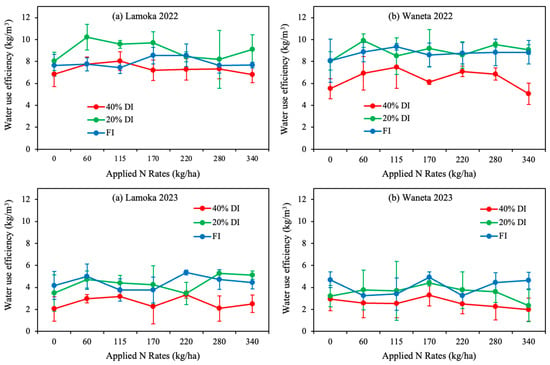
Figure 13.
Water use efficiency of Lamoka (a) and Waneta (b) under combinations of irrigation, full irrigation (FI) and deficit irrigation (DI), and nitrogen treatments in 2022 and 2023.
3.5. Nitrogen Use Efficiency (NUE)
The highest NUE values were achieved with 60 kg N/ha under 20% water-saving irrigation for both potato varieties and both growing seasons. The highest NUE (kg yield/kg N) for Lamoka under the FI, 20% DI and 40% DI irrigation regimes were obtained at N applied rates of 170 kg N/ha (31.36), 60 kg N/ha (194.53), and 60 kg N/ha (73.14) in 2022, respectively, and all three irrigation regimes had their highest NUE values at 60 kg N/ha in 2023 (Figure 14). For Waneta, all irrigation regimes had the highest NUE at 60 kg N/ha in 2022, whereas the highest NUE values (kg yield/kg N) for FI, 20% DI, and 40% DI irrigation regimes were obtained at 170 kg N/ha (9.06), 60 kg N/ha (50.55) and 170 kg N/ha (0.01) in 2023, respectively. The average NUE (kg yield/kg N) for Lamoka and Waneta were 30.6 and 41.4, respectively, in 2022 and 27.6 and −12.1, respectively, in 2023. The average NUE for Lamoka was 25.1% lower than that of Waneta in 2022, whereas the average NUE of Lamoka was 328.1% greater than that of Waneta in 2023.
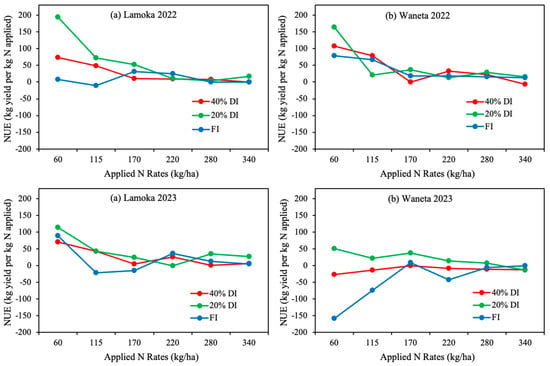
Figure 14.
Nitrogen use efficiency of Lamoka (a) and Waneta(b) under combinations of irrigation, full irrigation (FI) and deficit irrigation (DI), and nitrogen treatments in 2022 and 2023.
4. Discussion
4.1. Plant Growth Parameters
The higher plant height and canopy cover under full irrigation (FI) and 20% deficit irrigation (DI) were due to sufficient water and nutrient uptake by the plants required for optimum crop growth and development. However, the lower plant height and canopy cover under 40% DI could be due to extreme water stress coupled with heat stress that limited water and soil nutrient uptake by the plants, resulting in lower plant height and canopy cover. Yuan et al. [29] reported reduced plant height and number of branches per plant with reduced irrigation rates. Aytekin and Çaliskan [30] also reported significantly higher plant height under full irrigation than 33% and 66% deficit irrigation regimes. However, Elhani et al. [31] did not find significant difference in plant height and stem number per plant among full irrigation, 20% DI, 30% DI, and 50% DI irrigation regimes when potatoes were grown under glasshouse conditions.
The lower plant height and canopy cover under nitrogen control plots could be due to insufficient nitrogen supply to the plants that limited plant growth and development. However, other N fertilizer-treated plots had produced higher plant height and canopy cover than N control plot. The results are in accordance with Satognon et al. [32] who found significantly higher plant height and number of branches per plant under N fertilizer-treated plots than the N control plots. However, Akkamis and Caliskan [33] reported that potato plant height increased with an increase in N rates up to 400 kg N/ha in 2021; while there were no significant differences in plant height among N rates of 0, 100, 200, 300, 400, and 500 kg N/ha in 2023. Nitrogen treatments other than 0 kg N/ha had no distinct differences among them in plant height and canopy cover. That could be due to two possible reasons: first, our soil test results showed the soil consisted of 24.3 kg N/ha up to the depth of 120 cm before planting, and second, there could be mineralization of organic residues throughout the growing season which might have been increased with the irrigation depth. The lower plant height and canopy cover in 2023 compared to 2022 could be due to consistently high maximum air temperatures during the months of June, July and August in 2023. There were 32 and 45 days with a high air temperature exceeding 90 °F (32.2 °C) in 2022 and 2023, respectively.
4.2. Plant Physiological Parameters
Deficit irrigation (DI) regimes had higher SPAD meter values compared to full irrigation (FI) because of the dilution of chlorophyll concentration in FI due to higher biomass production translated into higher canopy cover under FI. The results are in accordance with Ramirez et al. [34] and Li et al. [35], who reported higher chlorophyll concentration of potato plants grown under deficit irrigations that stayed green for longer time with reduced senescence rate and lower tuber yield as compared to full irrigation. Romero et al. [36] also reported higher chlorophyll concentration in potatoes grown under water stressed conditions. The SPAD values were higher in N fertilizer-treated plots than nitrogen control plots. These results agreed with Ziadi et al. [37] who found significantly higher SPAD meter readings in nitrogen-treated plots (44.9) compared to nitrogen-controlled plots (40.5). The SPAD values increased with the increase in applied N rates in Lamoka. A similar trend of increased SPAD values and chlorophyll concentration with increasing N rates was observed by Guler [38] and Zaeen et al. [39].
Higher stomatal conductivity under FI and 20% DI compared to 40% DI was due to higher leaf water content and higher soil moisture availability under these irrigation regimes. The lower stomatal conductance under 40% DI could be due to the plant’s tendency to close stomata under extreme water and heat stress as an effort by plants to save water content in the leaves and shoots by reducing transpiration [40,41]. Liu et al. [42] reported significantly lower stomatal conductance of open-field potatoes under partial root-zone drying at 30% deficit irrigation as compared to full irrigation. Ahmadi et al. [43] also reported higher stomatal conductance of potatoes under full irrigation as compared to 35% deficit irrigation and partial root-zone drying irrigation; however, the differences were not significant.
4.3. Tuber Yield and Yield Components
Irrespective of N rates and potato variety, the lowest tuber number under 40% deficit irrigation (DI) was due to poor plant growth and development, as evidenced by lower plant height and canopy cover under 40% DI as well as the lower ability of potato plants to uptake enough water and nutrients from soil under water stressed condition. Ayetkin and Caliskan [30] also reported significantly lower tuber number and marketable tuber ratio under 66% deficit irrigation as compared to 33% deficit irrigation and full irrigation. The potato plants under 20% DI produced statistically similar tuber number with full irrigation as the plants under 20% DI were able to maintain optimum plant height and canopy cover under moderate water stress condition. Akkamis and Caliskan [33] also found statistically similar tuber number per plant between full irrigation and irrigation regime with 66% of field capacity (FC); however, the tuber yield was significantly lower under 66% FC irrigation treatment. Karam et al. [44] found significantly higher numbers of small-sized non-marketable tubers (tubers weighing < 85 g) when irrigation was cut-off for two weeks during tuber bulking stage as compared to full irrigation. The non-significant effect of nitrogen application rates on the tuber number was also reported by Badr et al. [45]. Similarly, Akkamis and Caliskan [33] did not find a significant difference in tuber number per plant among nitrogen rates ranging from 0 to 500 kg N/ha in one of the two growing seasons.
Significantly lower marketable and total tuber yields under severe DI irrigation were reported by several other researchers. Elhani et al. [31] recorded 40% tuber yield reduction per plant when the irrigation amount was reduced by 50% as compared to full irrigation. Averaged over fertilizer rates, varieties, and year, the tuber yield under 100% ETc irrigation regime was only 5.5% greater than that of 80% ETc irrigation while it was 31.4% greater than irrigation with 60% ETc requirement [46]. When irrigation was cut-off for two weeks during either tuber bulking or tuber ripening, there was significant reduction in marketable and total tuber yield as compared to full irrigation [44]. During severe water stress conditions, plants attempt to adjust with drought by reducing transpiration, photosynthetic activity, and stomatal conductance [40] and accelerate the production of secondary metabolites reducing translocation of assimilates into the tubers [47,48] and thus, finally result in poor plant growth and reduced tuber yield.
Al-Omran et al. [49] also reported that the partial root-zone drying with 75% ETc did not result in significant yield loss as compared to full irrigation with 100% ETc. Crosby and Wang [50] also concluded that 25% deficit irrigation during late bulking and maturation stage could save significant irrigation water maintaining optimum tuber yield and quality, while over-irrigation with 125% ETc not being profitable compared to full irrigation in chipping potatoes. The varietal and seasonal differences in crop performance and tuber yield were also reported by Crosby and Wang [50]. The lower tuber yield in 2023 compared to 2022 could be due to extreme weather conditions, such as heat during the day and very cold temperatures at night. The weather condition was drier and hotter in 2023 than in 2022, as experienced by higher maximum air temperature and lower relative humidity in 2023 growing season. Potato is a vulnerable crop to high temperature stress above 20 ℃ that could potentially reduce tuber yield by impairing the photosynthetic assimilation into potato tubers [41]. Extreme weather conditions, including high temperature, drought, and heavy rainfall, are responsible for approximately 18–43% of variations in seasonal crop yield [51]. Lamoka had similar yield as Waneta in 2022 but had greater yield than Waneta in 2023, suggesting the suitability of Lamoka variety in the semi-arid climatic region of the study site. Among N rates of 0, 60, 120, 180, and 240 kg N/ha, Nyiraneza et al. [52] reported that the highest marketable tuber yield of Russet Burbank was obtained with 120 kg N/ha and 180 kg N/ha in 2014 and 2015, respectively. Another study investigating different N application rates ranging from 0 to 240 kg N/ha in potato revealed a significant increase in tuber yield with N fertilization rates up to 150 kg N/ha only [53]. Makani et al. [54] observed the highest marketable and total tuber yields under 224 kg N/ha, which was statistically similar to 112 kg N/ha in the first season of the experiment. The N application rates did not significantly affect the tuber yield and yield components, which could be due to residual soil nitrogen before planting and the mineralization of organic matter during crop growth and development stages. The results are similar to Akkamis and Caliskan [33], who also did not find significant difference in tuber yield among nitrogen application rates ranging from 0 to 500 kg N/ha. The nitrate-nitrogen content in the soil has a quantitative relationship with potato tuber yield [55]. Hence, there should be a proper examination of soil nitrogen content and the crop history of the field prior to potato planting.
4.4. Water and Nitrogen Use Efficiencies
The water-saving irrigation strategy has great potential to improve WUE by reducing water loss through plant leaf transpiration and soil water evaporation [56]. Similar to the WUE results observed in this experiment, the highest water use efficiency (WUE) values were obtained with deficit irrigation treatments as compared to full irrigation [45]. Al-Omran et al. [49] and Crosby and Wang [19] reported reduced water use efficiency with increased irrigation rates. The WUE values recorded in this experiment are in accordance with the WUE reported by Al-Omran et al. [49] (2.77 to 8.38 kg/m3) and by Crosby and Wang [19] (5.9 to 8.1 kg/m3). The higher WUE under 20% DI irrigation in this experiment supports the findings of Kumar et al. [57], who reported the highest WUE (13.1 kg/m3) in potato under irrigation regimes with 80% of open pan evapotranspiration. Elhani et al. [31] also reported significantly higher irrigation water use efficiency (IWUE) at 50% and 70% DI irrigation as compared to irrigation at 100% field capacity (FC). The partial root-zone drying irrigation strategy that applied at least 30% less irrigation amount than the full irrigation resulted in increased IWUE by 38% and 61% in 2007 and 2008, respectively, along with producing similar tuber yield as full irrigation [47].
Nitrogen use efficiency (NUE) in potato crops could be reduced with increased rates of N fertilizer application [14,45]. NUE was found to be higher under 60 kg N/ha, and it decreased with N rates beyond 60 kg N/ha for Lamoka and Waneta in 2022 and only Lamoka in 2023. Similar results were reported by Ierna and Mauromicale [58], who found higher NUE under N application rate of 100 kg N/ha while the NUE decreased with subsequent increase in the N rates up to 500 kg N/ha. Makani et al. [59] also demonstrated the possibility of improving NUE by applying 112 kg N/ha for early maturing potato varieties. The relatively higher NUE values under deficit irrigation regimes compared to full irrigation could be due to reduced nitrate leaching beyond the crop root zone [21]. Xing et al. [46] also found that irrigation with 80% ETc with fertilizer rates of 120:60:150 kg/ha of N:P2O5:K2O and 60% ETc with fertilizer rates of 180:90:225 kg/ha of N:P2O5:K2O as the best water and nitrogen management combinations for ‘Feiurita’ variety in sandy loam soils of China. The negative NUE values were observed because of the higher tuber yield under nitrogen control plots (i.e., 0 kg N/ha) than N-treated plots.
5. Conclusions
For sustainable potato production, a 20% deficit irrigation strategy with a lower nitrogen rate (60–170 kg N/ha) could be the best option for improving water and nitrogen use efficiencies with minimal reduction in tuber yield. Our study suggested that 40% deficit irrigation resulted in significantly higher tuber yield reduction than both full irrigation and 20% deficit irrigation. The 20% cut-off in irrigation amount reduced the total tuber yield by 4.5% and 22.1% in the 2022 and 2023 growing seasons, respectively, while the 40% cut-off in the irrigation amount reduced total tuber yield by 36.8% and 58.2% in the 2022 and 2023 growing seasons, respectively, as compared to full irrigation. Irrigation water saved under 20% deficit irrigation regimes reached 711.2 m3/ha and 1036.3 m3/ha in 2022 and 2023, respectively. Compared to Waneta, Lamoka showed better growth and yield under the climatic conditions of Farmington, New Mexico.
Author Contributions
Conceptualization, K.D. and C.H.; methodology, K.D., B.S., C.H., M.K.D., B.L.S., K.A.L. and S.S.; formal analysis, B.S., K.D., S.S. and M.K.D.; investigation, K.D., B.S. and C.H.; resources, K.D.; data curation, B.S., K.D., B.L.S., S.S. and M.K.D.; writing—original draft preparation, B.S., K.D. and M.K.D.; writing—review and editing, B.S., K.D., S.S., M.K.D., B.L.S. and K.A.L.; supervision, K.D.; project administration, K.D.; funding acquisition, K.D. All authors have read and agreed to the published version of the manuscript.
Funding
This research received no external funding.
Data Availability Statement
The data presented in this study are available on request from the corresponding author.
Acknowledgments
This work was completed with the support of New Mexico State University (NMSU) and the Agricultural Science Center at Farmington. We appreciate Margaret West, Franklin Jason Thomas, Jonah Joh, Gasper Martinez, Brandon Francis, and Dallen Begay, who worked very hard on plot layout, management, and data collection and analysis.
Conflicts of Interest
Author Charles Higgins was employed by the company Higgins Farms Inc. The remaining authors declare that the research was conducted in the absence of any commercial or financial relationships that could be construed as a potential conflict of interest.
References
- FAOSTAT. Food and Agriculture Organization of the United Nations. 2021. Available online: https://www.fao.org/faostat/en/#data/QCL (accessed on 4 December 2023).
- United States Department of Agriculture (USDA). Potatoes 2022 Summary; United States Department of Agriculture (USDA): Washington, DC, USA, 2023.
- DeFauw, S.L.; He, Z.; Larkin, R.P.; Mansour, S.A. Sustainable Potato Production and Global Food Security. In Sustainable Potato Production: Global Case Studies; He, Z., Larkin, R., Honeycutt, W., Eds.; Springer: Dordrecht, The Netherlands, 2012. [Google Scholar] [CrossRef]
- Devaux, A.; Kromann, P.; Ortiz, O. Potatoes for sustainable global food security. Potato Res. 2014, 57, 185–199. [Google Scholar] [CrossRef]
- Devaux, A.; Goffart, J.-P.; Petsakos, A.; Kromann, P.; Gatto, M.; Okello, J.; Suarez, V. Global Food Security, Contributions from Sustainable Potato Agri-Food Systems. In The Potato Crop; Campos, H., Ortiz, O., Eds.; Springer: Cham, Switzerland, 2020. [Google Scholar] [CrossRef]
- Djaman, K.; Irmak, S.; Koudahe, K.; Allen, S. Irrigation management in potato (Solanum tuberosum L.) production: A Review. Sustainability 2021, 13, 1504. [Google Scholar] [CrossRef]
- Djaman, K.; Koudahe, K.; Saibou, A.; Darapuneni, M.; Higgins, C.; Irmak, S. Soil water dynamics, effective rooting zone, and evapotranspiration of sprinkler irrigated potato in a sandy loam soil. Agronomy 2022, 12, 864. [Google Scholar] [CrossRef]
- Sood, M.C.; Singh, N. Water management. In The Potato: Production and Utilization in Sub-Tropics; Khurana, S.M.P., Minhas, J.S., Pandey, S.K., Eds.; Mehta Publishers: New Dehli, India, 2003; pp. 111–112. [Google Scholar]
- United States Department of Agriculture. USDA Census of Irrigation [2018 Irrigation and Water Management Survey]. 2020. Available online: https://nawi.openei.org/submissions/8 (accessed on 29 February 2024).
- Terrell, B.L.; Johnson, P.N.; Segarra, E. Ogallala aquifer depletion: Economic impact on the Texas high plains. Water Policy 2002, 4, 33–46. [Google Scholar] [CrossRef]
- McGuire, V.L. Water-level changes and change in water in storage in the High Plains aquifer, predevelopment to 2013 and 2011–13. In Scientific Investigations Report (2014–5218); U.S. Geological Survey: Reston, VA, USA, 2014. [Google Scholar] [CrossRef]
- Hopkins, B.G.; Stark, J.C.; Kelling, K.A. Nutrient management. In Potato Production Systems; Stark, J.C., Thornton, M., Nolte, P., Eds.; Springer International Publishing: New York City, NY, USA, 2020; pp. 155–202. [Google Scholar] [CrossRef]
- Fontes, P.C.R.; Braun, H.; Busato, C.; Cecon, P.R. Economic optimum nitrogen fertilization rates and nitrogen fertilization rate effects on tuber characteristics of potato cultivars. Potato Res. 2010, 53, 167–179. [Google Scholar] [CrossRef]
- Zotarelli, L.; Rens, L.R.; Cantliffe, D.J.; Stoffella, P.J.; Gergela, D.; Fourman, D. Nitrogen fertilizer rate and application timing for chipping potato cultivar Atlantic. Agron. J. 2014, 106, 2215–2226. [Google Scholar] [CrossRef]
- Hodges, T. Water nitrogen applications for potato: Commercial experimental rates compared to a simulation model. J. Sustain. Agric. 1999, 13, 79–90. [Google Scholar] [CrossRef]
- Clément, C.-C.; Cambouris, A.N.; Ziadi, N.; Zebarth, B.J.; Karam, A. Potato yield response and seasonal nitrate leaching as influenced by nitrogen management. Agronomy 2021, 11, 2055. [Google Scholar] [CrossRef]
- Vashisht, B.B.; Nigon, T.; Mulla, D.J.; Rosen, C.; Xu, H.; Twine, T.; Jalota, S.K. Adaptation of water and nitrogen management to future climates for sustaining potato yield in Minnesota: Field and simulation study. Agric. Water Manag. 2015, 152, 198–206. [Google Scholar] [CrossRef]
- Kassaye, K.T.; Yilma, W.A.; Fisha, M.H.; Haile, D.H. Yield and water use efficiency of potato under alternate furrows and deficit irrigation. Int. J. Agron. 2020, 2020, e8869098. [Google Scholar] [CrossRef]
- Crosby, T.W.; Wang, Y. Effects of irrigation management on chipping potato (Solanum tuberosum L.) production in the Upper Midwest of the U.S. Agronomy 2021, 11, 768. [Google Scholar] [CrossRef]
- Fereres, E.; Soriano, M.A. Deficit irrigation for reducing agricultural water use. J. Exp. Bot. 2007, 58, 147–159. [Google Scholar] [CrossRef]
- Shrestha, B.; Darapuneni, M.; Stringam, B.L.; Lombard, K.; Djaman, K. Irrigation Water and Nitrogen Fertilizer Management in Potato (Solanum tuberosum L.): A Review. Agronomy 2023, 13, 2566. [Google Scholar] [CrossRef]
- United States Department of Agriculture, Natural Resources Conservation Service (USDA-NRCS). (2022). Web Soil Survey. Available online: https://websoilsurvey.nrcs.usda.gov/app/WebSoilSurvey.aspx (accessed on 16 May 2022).
- Christiansen, J.E. Irrigation by Sprinkling; University of California Agricultural Experiment Station Bulletin 670; University of California: Berkeley, CA, USA, 1942. [Google Scholar]
- Hatfield, J.L.; Dold, C. Water-use efficiency: Advances and challenges in a changing climate. Front. Plant Sci. 2019, 10, 103. [Google Scholar] [CrossRef]
- Djaman, K.; O’Neill, M.; Owen, C.K.; Smeal, D.; Koudahe, K.; West, M.; Allen, S.; Lombard, K.; Irmak, S. Crop evapotranspiration, irrigation water requirement and water productivity of maize from meteorological data under semiarid climate. Water 2018, 10, 405. [Google Scholar] [CrossRef]
- Moll, R.H.; Kamprath, E.J.; Jackson, W.A. Analysis and interpretation of factors which contribute to efficiency of nitrogen utilization. Agron. J. 1982, 74, 562–564. [Google Scholar] [CrossRef]
- Bates, D.; Maechler, M.; Bolker, B.; Walker, S. Fitting linear mixed-effects models using Lme4. J. Stat. Softw. 2015, 67, 1–48. [Google Scholar] [CrossRef]
- Lenth, R.V. Emmeans: Estimated Marginal Means, Aka Least-Squares Means. R Package Version 1.8.8. 2023. Available online: https://cran.r-project.org/web/packages/emmeans/index.html (accessed on 26 September 2023).
- Yuan, B.-Z.; Nishiyama, S.; Kang, Y. Effects of different irrigation regimes on the growth and yield of drip-irrigated potato. Agric. Water Manag. 2003, 63, 153–167. [Google Scholar] [CrossRef]
- Aytekin, R.İ.; Çalışkan, S. Irrigation and potassium fertilization effects on plant growth, tuber yield, quality, and water use efficiency of potato. Irrig. Sci. 2023, 42, 367–385. [Google Scholar] [CrossRef]
- Elhani, S.; Haddadi, M.; Csákvári, E.; Zantar, S.; Hamim, A.; Villányi, V.; Douaik, A.; Bánfalvi, Z. Effects of partial root-zone drying and deficit irrigation on yield, irrigation water-use efficiency and some potato (Solanum tuberosum L.) quality traits under glasshouse conditions. Agric. Water Manag. 2019, 224, 105745. [Google Scholar] [CrossRef]
- Satognon, F.; Owido, S.F.O.; Lelei, J.J. Effects of supplemental irrigation on yield, water use efficiency and nitrogen use efficiency of potato grown in mollic Andosols. Environ. Syst. Res. 2021, 10, 38. [Google Scholar] [CrossRef]
- Akkamis, M.; Caliskan, S. Responses of yield, quality and water use efficiency of potato grown under different drip irrigation and nitrogen levels. Sci. Rep. 2023, 13, 9911. [Google Scholar] [CrossRef]
- Ramírez, D.A.; Yactayo, W.; Gutiérrez, R.; Mares, V.; De Mendiburu, F.; Posadas, A.; Quiroz, R. Chlorophyll concentration in leaves is an indicator of potato tuber yield in water-shortage conditions. Sci. Hortic. 2014, 168, 202–209. [Google Scholar] [CrossRef]
- Li, S.; Kupriyanovich, Y.; Wagg, C.; Zheng, F.; Hann, S. Water deficit duration affects potato plant growth, yield and tuber quality. Agriculture 2023, 13, 2007. [Google Scholar] [CrossRef]
- Romero, A.P.; Alarcón, A.; Valbuena, R.I.; Galeano, C.H. Physiological assessment of water stress in potato using spectral information. Front. Plant Sci. 2017, 8. [Google Scholar] [CrossRef]
- Ziadi, N.; Grant, C.; Samson, N.; Nyiraneza, J.; Bélanger, G.; Parent, L.-É. Efficiency of controlled-release urea for a potato production system in Quebec, Canada. Agron. J. 2011, 103, 60–66. [Google Scholar] [CrossRef]
- Güler, S. Effects of nitrogen on yield and chlorophyll of potato (Solanum tuberosum L.) cultivars. Bangladesh J. Bot. 2009, 38, 2. [Google Scholar] [CrossRef]
- Zaeen, A.A.; KSharma, L.; Jasim, A.; Bali, S.; Buzza, A.; Alyokhin, A. Yield and quality of three potato cultivars under series of nitrogen rates. Agrosyst. Geosci. Environ. 2020, 3, e20062. [Google Scholar] [CrossRef]
- Boguszewska-Mańkowska, D.; Pieczyński, M.; Wyrzykowska, A.; Kalaji, H.M.; Sieczko, L.; Szweykowska-Kulińska, Z.; Zagdańska, B. Divergent strategies displayed by potato (Solanum tuberosum L.) cultivars to cope with soil drought. J. Agron. Crop Sci. 2018, 204, 13–30. [Google Scholar] [CrossRef]
- Lal, M.K.; Tiwari, R.K.; Kumar, A.; Dey, A.; Kumar, R.; Kumar, D.; Jaiswal, A.; Changan, S.S.; Raigond, P.; Dutt, S.; et al. Mechanistic concept of physiological, biochemical, and molecular responses of the potato crop to heat and drought stress. Plants 2022, 11, 2857. [Google Scholar] [CrossRef] [PubMed]
- Liu, F.; Shahnazari, A.; Andersen, M.N.; Jacobsen, S.-E.; Jensen, C.R. Effects of deficit irrigation (DI) and partial root drying (PRD) on gas exchange, biomass partitioning, and water use efficiency in potato. Sci. Hortic. 2006, 109, 113–117. [Google Scholar] [CrossRef]
- Ahmadi, S.H.; Andersen, M.N.; Plauborg, F.; Poulsen, R.T.; Jensen, C.R.; Sepaskhah, A.R.; Hansen, S. Effects of irrigation strategies and soils on field-grown potatoes: Gas exchange and xylem [ABA]. Agric. Water Manag. 2010, 97, 1486–1494. [Google Scholar] [CrossRef]
- Karam, F.; Amacha, N.; Fahed, S.; ELAsmar, T.; Domínguez, A. Response of potato to full and deficit irrigation under semiarid climate: Agronomic and economic implications. Agric. Water Manag. 2014, 142, 144–151. [Google Scholar] [CrossRef]
- Badr, M.A.; El-Tohamy, W.A.; Zaghloul, A.M. Yield and water use efficiency of potato grown under different irrigation and nitrogen levels in an arid region. Agric. Water Manag. 2012, 110, 9–15. [Google Scholar] [CrossRef]
- Xing, Y.; Zhang, T.; Jiang, W.; Li, P.; Shi, P.; Xu, G.; Cheng, S.; Cheng, Y.; Fan, Z.; Wang, X. Effects of irrigation and fertilization on different potato varieties growth, yield and resources use efficiency in the Northwest China. Agric. Water Manag. 2022, 261, 107351. [Google Scholar] [CrossRef]
- Jovanovic, Z.; Stikic, R.; Vucelic-Radovic, B.; Paukovic, M.; Brocic, Z.; Matovic, G.; Rovcanin, S.; Mojevic, M. Partial root-zone drying increases WUE, N and antioxidant content in field potatoes. Eur. J. Agron. 2010, 33, 124–131. [Google Scholar] [CrossRef]
- Yadav, B.; Jogawat, A.; Rahman, M.S.; Narayan, O.P. Secondary metabolites in the drought stress tolerance of crop plants: A review. Gene Rep. 2021, 23, 101040. [Google Scholar] [CrossRef]
- Al-Omran, A.; Louki, I.; Alkhasha, A.; Abd El-Wahed, M.H.; Obadi, A. Water saving and yield of potatoes under partial root-zone drying drip irrigation technique: Field and modelling study using SALTMED model in Saudi Arabia. Agronomy 2020, 10, 1997. [Google Scholar] [CrossRef]
- Crosby, T.W.; Wang, Y. Effects of different irrigation management practices on potato (Solanum tuberosum L.). Sustainability 2021, 13, 10187. [Google Scholar] [CrossRef]
- Vogel, E.; Donat, M.G.; Alexander, L.V.; Meinshausen, M.; Ray, D.K.; Karoly, D.; Meinshausen, N.; Frieler, K. The effects of climate extremes on global agricultural yields. Environ. Res. Lett. 2019, 14, 054010. [Google Scholar] [CrossRef]
- Nyiraneza, J.; Cambouris, A.N.; Nelson, A.; Khakbazan, M.; Mesbah, M.; Perron, I.; Ziadi, N.; Lafond, J. Potato yield, net revenue and specific gravity responses to nitrogen fertilizer under different Canadian agroecozones. Agronomy 2021, 11, 1392. [Google Scholar] [CrossRef]
- Liu, K.; Du, J.; Zhong, Y.; Shen, Z.; Yu, X. The response of potato tuber yield, nitrogen uptake, soil nitrate nitrogen to different nitrogen rates in red soil. Sci. Rep. 2021, 11, 22506. [Google Scholar] [CrossRef] [PubMed]
- Makani, M.N.; Zotarelli, L.; Sargent, S.A.; Huber, D.J.; Sims, C.A. Nitrogen fertilizer rate affects yield and tuber quality of drip-irrigated tablestock potatoes (Solanum tuberosum L.) Grown under Subtropical Conditions. Am. J. Potato Res. 2020, 97, 605–614. [Google Scholar] [CrossRef]
- Nurmanov, Y.T.; Chernenok, V.G.; Kuzdanova, R.S. Potato in response to nitrogen nutrition regime and nitrogen fertilization. Field Crops Res. 2019, 231, 115–121. [Google Scholar] [CrossRef]
- Yang, M.-D.; Leghari, S.J.; Guan, X.-K.; Ma, S.-C.; Ding, C.-M.; Mei, F.-J.; Wei, L.; Wang, T.-C. Deficit subsurface drip irrigation improves water use efficiency and stabilizes yield by enhancing subsoil water extraction in winter wheat. Front. Plant Sci. 2020, 11, 508. [Google Scholar] [CrossRef]
- Kumar, P.; Pandey, S.K.; Singh, B.P.; Singh, S.V.; Kumar, D. Effect of nitrogen rate on growth, yield, economics and crisps quality of Indian potato processing cultivars. Potato Res. 2007, 50, 143–155. [Google Scholar] [CrossRef]
- Ierna, A.; Mauromicale, G. Sustainable and profitable nitrogen fertilization management of potato. Agronomy 2019, 9, 582. [Google Scholar] [CrossRef]
- Makani, M.N.; Sargent, S.A.; Zotarelli, L.; Huber, D.J.; Sims, C.A. Harvest interval has greater effect on periderm maturity and storage quality of early-maturing, tablestock potato than nitrogen rate. HortScience 2017, 52, 1390–1395. [Google Scholar] [CrossRef]
Disclaimer/Publisher’s Note: The statements, opinions and data contained in all publications are solely those of the individual author(s) and contributor(s) and not of MDPI and/or the editor(s). MDPI and/or the editor(s) disclaim responsibility for any injury to people or property resulting from any ideas, methods, instructions or products referred to in the content. |
© 2024 by the authors. Licensee MDPI, Basel, Switzerland. This article is an open access article distributed under the terms and conditions of the Creative Commons Attribution (CC BY) license (https://creativecommons.org/licenses/by/4.0/).